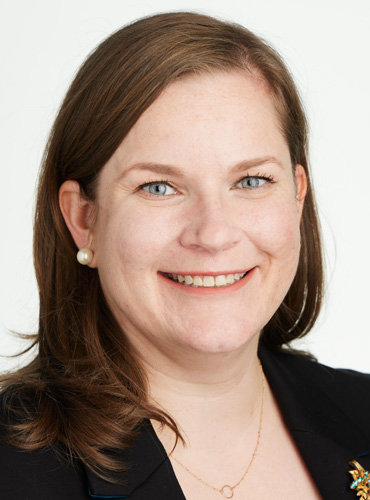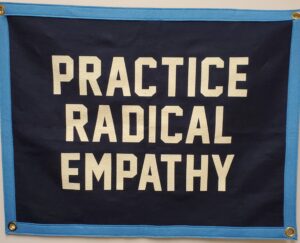
If you ask Meghan McPherson what led her to a successful career in emergency management, she’ll tell you quite plainly, disasters. During her undergraduate degree, she took part in a student conference at West Point and was assigned to a policy working group discussing the newly formed Department of Homeland Security. It was during the aftermath of 9/11 and McPherson was fascinated by the workings of the department. So much so, she decided to forget about law school and pivoted, dedicating her career to emergency management.
Since, McPherson has witnessed some of the worst disasters our country has faced, from the aftermath of Hurricane Katrina to most recently, the frontlines of the COVID-19 pandemic, as the Director of Emergency Management for Mount Sinai Queens Hospital in New York City.
McPherson earned her BA in political science at the University of New Hampshire and her Master of Public Policy (MPP) with a concentration in national security policy from The George Washington University. She is a Certified Emergency Manager (CEM), Certified National Healthcare Disaster Professional (NHDP-BC), and a Certified Healthcare Provider Continuity Professional (CHPCP).
Below, McPherson discusses how she got her start in emergency management, what the past two years have been like on the front lines of the COVID-19 pandemic, and what she thinks makes for a great emergency management professional.
How did you get into Emergency Management?
Ironically, disasters lead me to emergency management. When I was a senior at the University of New Hampshire, my favorite professor, Colonel Lionel Ingram (ret.), nominated me for a program called Student Conference on US Affairs at West Point. I was assigned to the policy working group titled for a newly formed federal department of the same name— “Homeland Security.”
In the aftermath of 9/11 and through the creation of this department, I found the subject matter fascinating and decided to forget about law school! I entered The George Washington University the next year and earned a master’s degree in public policy, with a concentration in national security policy. While there, I had the opportunity to be a graduate assistant for the newly formed House of Representatives Homeland Security Committee. My second day at the office, Hurricane Katrina hit the gulf coast and devastated the district of our Ranking Member, Representative Bennie Thompson. I spent that semester working on emergency management issues, broadening my man-made hazard lens to an all-hazard one, and I have never looked back.
You were deployed multiple times to support recovery efforts following Hurricane Katrina. What was that experience like?
I deployed during the recovery efforts as a part of my position at James Lee Witt Associates roughly a year after the storm. As part of my assignment, I was detailed to the Joint Field Office (JFO) in Baton Rouge, Louisiana. My work centered on the hazard mitigation grant program (HMGP). This was an amazing experience as I learned from those who had been through so many storms in the gulf region. My assignment took me to meetings with local jurisdictions to discuss their projects and to help bring them to fruition. Though I had worked on these projects back at the home office in DC as well, the experience of deploying was unmatched. I also fell in love with the city of New Orleans, developing friendships that last to this day!
More recently, you were on the front lines of the COVID-19 pandemic as the Director of Emergency Management for Mount Sinai Queens Hospital in NYC. As you look back on the experience, what stands out to you?
So many things are now in my bones from this experience. The last 2 years have been, by far, the most challenging of my career.
Many times in emergency management, we are in the emergency operations center. Responding to COVID has been a daily front row seat to more suffering than I could have imagined, both by the patients and for their grieving families. My hospital supports a community whose characteristics made it extremely vulnerable, as it became the epicenter of the epicenter. We are a borough that contains many essential workers who live in multi-generational homes. Especially in the earliest days of the pandemic, these characteristics allowed the pandemic to spread at lightning speed through neighborhoods and families.
What also sticks out to me is the teamwork and the love for this community that never waned at my hospital. Day after day, month after month, and now year after year, the staff of this hospital have shown up to take care of our patients.
That sounds incredibly challenging, even for the most experienced Emergency Manager.
The initial surge of COVID in New York City was something no one could be mentally prepared for. We worried every day if we would become ill or if you would bring it home to your family.
Response is known as the shortest phase of emergency management, usually lasting only a small period, before recovery begins. Yet, with each variant of COVID-19, we continue to respond, while operationalizing mass vaccination efforts and dealing with other compounding hazards at the same time.
I am grateful I went through the experience with incredible colleagues who never gave up on the darkest days. The entire experience has been rewarding in its own way.
COVID aside, what do you think are the biggest challenges facing today’s emergency management professionals?
There are so many challenges, but one of the biggest is not a specific type of threat, rather compounding threats that have cascading impacts. The threat environment itself has grown with domestic and international extremism, coupled with the ramifications of climate change. It is important to remember that these threats do not come one at a time. While responding to COVID, we had blizzards, hurricanes, power outages, civil unrest, and domestic terror threats. The compounding nature of the current threat environment should be included in exercise scenarios and planning discussions in ways that were not common in the past.

Photo: Courtesy of Meghan McPherson
What do you think makes someone a great emergency manager?
The best emergency managers I have known are creative, flexible, empathetic, and center their lives on serving others. They are confident enough to be able to pivot in the moment when things don’t go according to plan, as they rarely do! Creativity allows for an approach to all phases of emergency management with any random issue that comes their way.
Finally, I cannot stress the importance of leading with empathy. I had a sign made for my office that says, “Practice Radical Empathy.” Whether working in a hospital, a Joint Field Office, or in an EOC, you need to put yourself in the shoes of those impacted by the disaster and determine what you can do to help them through such a difficult time.
You co-founded and serve as Co-Director of the Pracademic Affairs Journal. How did that come to be?
My colleague, Dr. Michael Wallace, and I have served on quite a few academic journal review boards over the years. We found there was a significant opportunity gap in the current publication environment for emergency management and homeland security professionals. In the summer of 2020, we pitched a new idea to the editors of Homeland Security Affairs Journal to launch an affiliated eJournal.
Our mission is to provide emergency management and homeland security practitioners a welcoming platform to write, explore, analyze, and examine real-world critical lessons learned to improve the resilience of our communities.
Our program’s curriculum focuses on communication and collaboration with stakeholders and communities, ethical leadership, and building resilience. In your opinion, why are these themes so important?
These overarching themes could not be more important to the success of an emergency manager, as emergency management is a group activity. No matter what sector you work in, you approach this discipline from a place of collaboration, with your specific stakeholders and community. You cannot be successful on your own and in a silo. Building the trust and relationships plus preparing those in your jurisdiction for the worst scenario inherently builds the resilience essential for these areas to thrive in future events.
What do you enjoy about teaching emergency management?
I have found the last 10 years of teaching emergency management to be exceptionally rewarding. Watching your students grow, achieve, and be successful in a field you are passionate about is a soul affirming experience. I am so proud to have been a small part of their journey.
As you know, Emergency Management can be intense and all encompassing. What do you like to do for fun or to recharge?
When I am able, I love to travel and bring along my camera as a part of those adventures with my partner, Ben, and our 12.5-year-old rescue dachshund, Sam.
Learn more about the MS in Emergency Management program.


